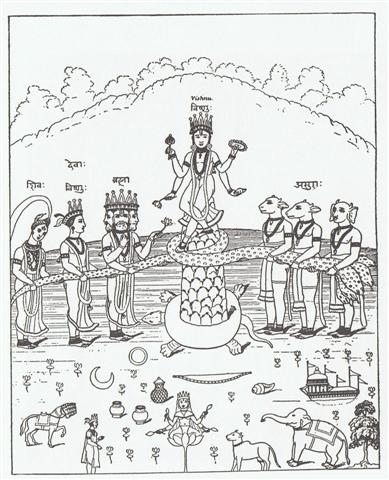|
In Hamlet's Mill
focus is single-mindedly on the precession of the equinoxes. I have
always felt this view to be halting. A more reasonable explanation for the
battle between the forces of light and darkness is simply to look
outside at mother nature. The tug of war is basically that between
summer and winter:
The two-horned 'beasts' at right rule spring and they have two arms each. The front part of the 5-headed (rima, fire) serpent belongs to them and together they have 6 'arms' (meaning months) as the measure for the length of spring. The tail of the 'feathered serpent' is held by the cultured people at left, those who are representing humanity and gods. They also number 3, but their arms are 2 + 2 + 4 = 8. The pair at left with only 2 arms resemble the 3 beasts at right. Presumably 3 + 2 = 5 refers to the 5 double-months dominated by the sun. The woman at left could represent Venus and her husband would then be the following Saturn. He has a crown with 3 'counters'. If Venus counts as a double-month, being close to the beasts in position and also in character, then she will have the perfect number 8. For Saturn we can then count 3, and 8 + 3 = 11, a number which could mean 'one more' (i.e. together with Venus he generates a new sun, son). The curious triple-headed god which follows Saturn ought to refer to Janus as he stands at the threshold to the new calendar year, and beyond Saturn comes Sun. In a central position at the top of the 'mountain' rules the Moon, therefore Sun should be also at the other end (at center bottom). The Moon is ruling over time and therefore she is at the top and the sun turtle will be at the bottom. Top and bottom are interconnected. When the cosmic tree turns at the top (of the 'mill') then also the bottom is turning. On the turtle the friction will then generate a new fire:
Turtles are curiously able to withstand fire for a long time without beeing cooked. The 3 stones probably represent the 3 double-months of spring (and also the 3 counters in the crown of Saturn). Counting all the arms (months) we must add the 4 of Moon to 6 + 8, which gives 18, a measure which can be explained as 360 / 20. A month is measured as 20 days. Tangaroa Uri is the month October, corresponding to April north of the equator. April 1 is the date when we must be aware lest somebody fools us. Only by trickery can summer win over winter. As a little child there is no other way to succeed. The fishing taboo is over and it is now OK to lift the fishes up (reva) from the sea, haul them onto land. In French they have a saying 'donner une poisson' (give a fish [as a present to somebody]) which is said on April 1. The winter season is the season of Tagaroa and when he has been defeated by the summer season there is no longer any danger connected with handling fishes. The taboo is over. Thank you for that! Hakakio should mean make (haka) summer (kio). The 'land' has won, has returned, and Te Kioe Uri is another expression of this. The Black Rat symbolizes the land rising above the sea. It is 'ebb' again and the 'tidal flats' can be scavenged to fill the empty stomachs. Also fishes can be caught in the tidal pools. |

